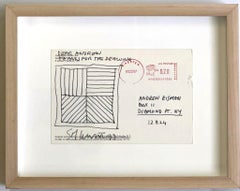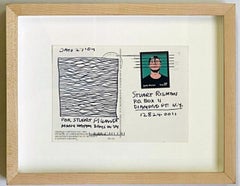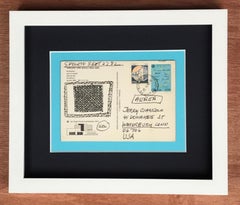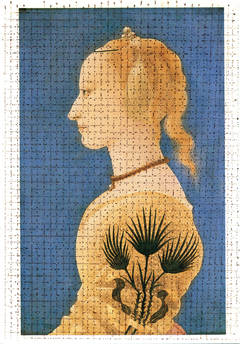Sol Lewitt Postcard
1990s Minimalist Abstract Drawings and Watercolors
Postcard, Felt Pen
Early 2000s Minimalist Abstract Drawings and Watercolors
Postcard, Felt Pen
1980s Abstract Geometric Abstract Drawings and Watercolors
Ink, Postcard, Mixed Media, Offset
Recent Sales
20th Century Abstract Mixed Media
Mixed Media
People Also Browsed
Mid-20th Century American Modern Figurative Drawings and Watercolors
Paper, Graphite
21st Century and Contemporary Modern Planters and Jardinieres
Cement
1990s Italian Mid-Century Modern Chandeliers and Pendants
Brass
2010s American Modern Contemporary Art
Paper
2010s Italian Mid-Century Modern Side Tables
Steel
21st Century and Contemporary Indian Modern Tableware
Iron
21st Century and Contemporary Italian Modern Coffee and Cocktail Tables
Blown Glass
1970s Surrealist Abstract Prints
Etching
Vintage 1960s American Mid-Century Modern Dressers
Metal
20th Century Pop Art Abstract Prints
Paper, Lithograph
2010s Dutch Modern Side Tables
Marble
2010s British Scandinavian Modern Ottomans and Poufs
Sheepskin, Oak
Early 17th Century Old Masters Portrait Paintings
Oil
1960s Art Deco Figurative Drawings and Watercolors
Archival Paper
21st Century and Contemporary Portuguese Modern Vases
Gold
2010s Naturalistic Landscape Drawings and Watercolors
Watercolor, Rag Paper
Sol LeWitt for sale on 1stDibs
While New York City’s art scene in the 1950s and ’60s revolved around Abstract Expressionism, multidisciplinary artist Sol LeWitt paved an alternative path, creating a prolific output of work in the genres of minimalism and, later, Conceptual art.
While LeWitt is perhaps best known for his immense “wall drawings,” he created work in a wide range of media, including drawing, painting, printmaking and sculpture. (However, in a characteristic rebuttal of canonical art history, he referred to these pieces as “structures.”) He also produced several texts, including the seminal Sentences on Conceptual Art (1969).
Born in Hartford, Connecticut, in 1928, LeWitt received a BFA from Syracuse University before going to work as a graphic designer for the renowned architect I.M. Pei. He would later work at the book counter at the Museum of Modern Art, where his colleagues included fellow artists. LeWitt’s early exposure to architecture may well have had outsize influence on his subsequent career: He was known for the geometric nature of his work, specifically his fastidious, near-obsessive treatment of the cube, which he rendered repeatedly in various ways throughout his paintings, structures and wall drawings.
In the 1960s, LeWitt showed in several group exhibitions throughout New York and also began to experiment with three-dimensional structures, most modular riffs on the cube shape. His work was included in “Working Drawings and Other Visible Things on Paper Not Necessarily Meant to Be Viewed as Art,” curated by Mel Bochner, another leading exponent of Conceptualism.
Later, LeWitt debuted his now-iconic wall drawings, creating work directly on the walls of galleries and show spaces, beginning with pioneering gallerist Paula Cooper’s inaugural show in 1968. The wall drawings became a prime example of LeWitt’s philosophical approach to art, with their installation often carried out by museum staff or curators following precise instructions from the artist.
“The idea,” the artist once said, “becomes a machine that makes the art.” LeWitt continued to produce work until his death in 2007.
Find a collection of original Sol LeWitt art on 1stDibs.
Finding the Right Drawings-watercolor-paintings for You
Revitalize your interiors — introduce drawings and watercolor paintings to your home to evoke emotions, stir conversation and show off your personality and elevated taste.
Drawing is often considered one of the world’s oldest art forms, with historians pointing to cave art as evidence. In fact, a cave in South Africa, home to Stone Age–era artists, houses artwork that is believed to be around 73,000 years old. It has indeed been argued that cave walls were the canvases for early watercolorists as well as for landscape painters in general, who endeavor to depict and elevate natural scenery through their works of art. The supplies and methods used by artists and illustrators to create drawings and paintings have evolved over the years, and so too have the intentions. Artists can use their drawing and painting talents to observe and capture a moment, to explore or communicate ideas and convey or evoke emotion. No matter if an artist is working in charcoal or in watercolor and has chosen to portray the marvels of the pure human form, to create realistic depictions of animals in their natural habitats or perhaps to forge a new path that references the long history of abstract visual art, adding a drawing or watercolor painting to your living room or dining room that speaks to you will in turn speak to your guests and conjure stimulating energy in your space.
When you introduce a new piece of art into a common area of your home — a figurative painting by Italian watercolorist Mino Maccari or a colorful still life, such as a detailed botanical work by Deborah Eddy — you’re bringing in textures that can add visual weight to your interior design. You’ll also be creating a much-needed focal point that can instantly guide an eye toward a designated space, particularly in a room that sees a lot of foot traffic.
When you’re shopping for new visual art, whether it’s for your apartment or weekend house, remember to choose something that resonates. It doesn’t always need to make you happy, but you should at least enjoy its energy. On 1stDibs, browse a wide-ranging collection of drawings and watercolor paintings and find out how to arrange wall art when you’re ready to hang your new works.



